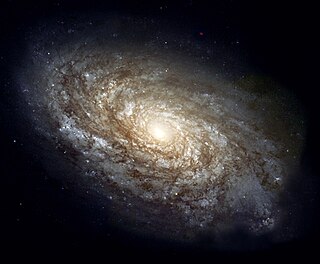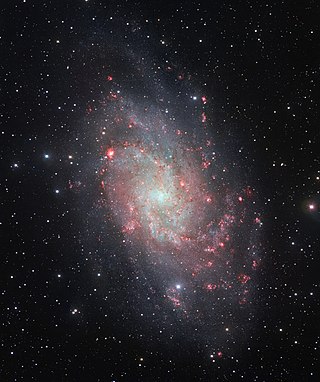
Fornax is a constellation in the southern celestial hemisphere, partly ringed by the celestial river Eridanus. Its name is Latin for furnace. It was named by French astronomer Nicolas Louis de Lacaille in 1756. Fornax is one of the 88 modern constellations.

A galaxy is a system of stars, stellar remnants, interstellar gas, dust, and dark matter bound together by gravity. The word is derived from the Greek galaxias (γαλαξίας), literally 'milky', a reference to the Milky Way galaxy that contains the Solar System. Galaxies, averaging an estimated 100 million stars, range in size from dwarfs with less than a thousand stars, to the largest galaxies known – supergiants with one hundred trillion stars, each orbiting its galaxy's center of mass. Most of the mass in a typical galaxy is in the form of dark matter, with only a few percent of that mass visible in the form of stars and nebulae. Supermassive black holes are a common feature at the centres of galaxies.

The Local Group is the galaxy group that includes the Milky Way, where Earth is located. It has a total diameter of roughly 3 megaparsecs (10 million light-years; 9×1019 kilometres), and a total mass of the order of 2×1012 solar masses (4×1042 kg). It consists of two collections of galaxies in a "dumbbell" shape; the Milky Way and its satellites form one lobe, and the Andromeda Galaxy and its satellites constitute the other. The two collections are separated by about 800 kiloparsecs (3×10^6 ly; 2×1019 km) and are moving toward one another with a velocity of 123 km/s. The group itself is a part of the larger Virgo Supercluster, which may be a part of the Laniakea Supercluster. The exact number of galaxies in the Local Group is unknown as some are occluded by the Milky Way; however, at least 80 members are known, most of which are dwarf galaxies.

Andromeda is one of the 48 constellations listed by the 2nd-century Greco-Roman astronomer Ptolemy, and one of the 88 modern constellations. Located in the northern celestial hemisphere, it is named for Andromeda, daughter of Cassiopeia, in the Greek myth, who was chained to a rock to be eaten by the sea monster Cetus. Andromeda is most prominent during autumn evenings in the Northern Hemisphere, along with several other constellations named for characters in the Perseus myth. Because of its northern declination, Andromeda is visible only north of 40° south latitude; for observers farther south, it lies below the horizon. It is one of the largest constellations, with an area of 722 square degrees. This is over 1,400 times the size of the full moon, 55% of the size of the largest constellation, Hydra, and over 10 times the size of the smallest constellation, Crux.

The Triangulum Galaxy is a spiral galaxy 2.73 million light-years (ly) from Earth in the constellation Triangulum. It is catalogued as Messier 33 or NGC (New General Catalogue) 598. With the D25 isophotal diameter of 18.74 kiloparsecs (61,100 light-years), the Triangulum Galaxy is the third-largest member of the Local Group of galaxies, behind the Andromeda Galaxy and the Milky Way.

An irregular galaxy is a galaxy that does not have a distinct regular shape, unlike a spiral or an elliptical galaxy. Irregular galaxies do not fall into any of the regular classes of the Hubble sequence, and they are often chaotic in appearance, with neither a nuclear bulge nor any trace of spiral arm structure.

A dwarf galaxy is a small galaxy composed of about 1000 up to several billion stars, as compared to the Milky Way's 200–400 billion stars. The Large Magellanic Cloud, which closely orbits the Milky Way and contains over 30 billion stars, is sometimes classified as a dwarf galaxy; others consider it a full-fledged galaxy. Dwarf galaxies' formation and activity are thought to be heavily influenced by interactions with larger galaxies. Astronomers identify numerous types of dwarf galaxies, based on their shape and composition.

The Pisces Dwarf, also known as Pisces I, is an irregular dwarf galaxy that is part of the Local Group. The galaxy, taking its name from the constellation Pisces where it appears, is suspected of being a satellite galaxy of the Triangulum Galaxy (M33). It displays a blueshift, as it is approaching the Milky Way at 287 km/s. It may be transition-type galaxy, somewhere between dwarf spheroidal and dwarf irregular. Alternatively, it may be a rare, but statistically acceptable, version of one of the two types.

NGC 2366 is a Magellanic barred irregular dwarf galaxy located in the constellation Camelopardalis.

In cosmology, galaxy filaments are the largest known structures in the universe, consisting of walls of galactic superclusters. These massive, thread-like formations can commonly reach 50/h to 80/h megaparsecs —with the largest found to date being the Hercules-Corona Borealis Great Wall at around 3 gigaparsecs (9.8 Gly) in length—and form the boundaries between voids. Due to the accelerating expansion of the universe, the individual clusters of gravitationally bound galaxies that make up galaxy filaments are moving away from each other at an accelerated rate; in the far future they will dissolve.

The Local Void is a vast, empty region of space, lying adjacent to the Local Group. Discovered by Brent Tully and Rick Fisher in 1987, the Local Void is now known to be composed of three separate sectors, separated by bridges of "wispy filaments". The precise extent of the void is unknown, but it is at least 45 Mpc across, and possibly 150 to 300 Mpc. The Local Void appears to have significantly fewer galaxies than expected from standard cosmology.
Pisces II is a dwarf spheroidal galaxy situated in the Pisces constellation and discovered in 2010 in the data obtained by the Sloan Digital Sky Survey. The galaxy is located at the distance of about 180 kpc (kiloparsecs) from the Sun. It is classified as a dwarf spheroidal galaxy (dSph) meaning that it has an elongated shape with the half-light radius of about 60 pc and ratio of the axis of about 5:3.
A void galaxy is a galaxy located in a cosmological void. Few galaxies exist in voids; most are located in sheets, walls and filaments that surround voids and supervoids. Many void galaxies are connected through void filaments or tendrils, less massive versions of the regular galaxy filaments that surround voids. These filaments are often straighter than their non-void counterparts due to the lack of influence by surrounding filaments. These filaments can even be rich enough to form poor galaxy clusters. The void galaxies themselves are thought to represent pristine examples of galactic evolution, having few neighbours, and likely to have formed from pure intergalactic gas.

NGC 6503 is a field dwarf spiral galaxy in the northern constellation of Draco. It was discovered by German astronomer Arthur von Auwers on July 22, 1854. The galaxy has an angular size of 7.1′ × 2.4′ and an apparent visual magnitude of 10.2. It is located at a distance of approximately 20.9 million light-years (6.40 Mpc) from the Milky Way galaxy. NGC 6503 may form the remote tip of a long chain of galaxies that extends out into the local void, forming a galaxy filament spanning 26 million light-years (8 Mpc).

KKR 03 is a dwarf irregular galaxy located 6.4 million light-years away from Earth. It has an absolute magnitude of −10.85 and lies on the inner edge of the M94 Group.

NGC 1084 is an unbarred spiral galaxy in the constellation Eridanus. It is located at a distance of about 63 million light-years away from the Milky Way. The galaxy was discovered by William Herschel on 10 January 1785. It has multiple spiral arms, which are not well defined. It belongs in the same galaxy group with NGC 988, NGC 991, NGC 1022, NGC 1035, NGC 1042, NGC 1047, NGC 1052 and NGC 1110. This group is in turn associated with the Messier 77 group.

Pisces A is a void dwarf galaxy. It is located in the Local Void, near Pisces B; and is in the Pisces constellation. It is 18.4 million light-years away from Earth. The galaxy was discovered with the WIYN Observatory. About 100 million years ago, the galaxy started moving out of the void and into the local filament zone and denser gaseous environment. This sparked off a doubling of the rate of star formation.
The KBC Void is an immense, comparatively empty region of space, named after astronomers Ryan Keenan, Amy Barger, and Lennox Cowie, who studied it in 2013. The existence of a local underdensity has been the subject of many pieces of literature and research articles.

The Local Volume is a collection of more than 500 galaxies located in an area of the observable universe near us, within a spherical region with a radius of 11 megaparsecs from Earth or up to a radial velocity of redshift of z < 0.002.
















